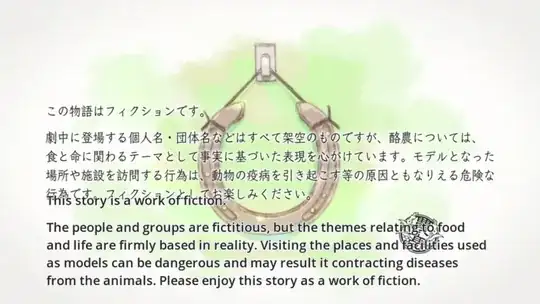If you read the message translated more literally, it is not quite so scary-sounding:
「劇中に登場する個人名・団体名などはすべて架空のものですが、酪農については、食と命に関わるテーマとして事実に基づいて表現を心がけています。モデルとなった場所や施設を訪問する行為は、動物の疫病を引き起こす等の原因ともなりえる危険な行為です。」
"All personal names and organizations that appear in this program are fictional, however, regarding dairy farms, [we are] committed to representing themes about food and life based on reality. Visiting the location or facilities used as models is a dangerous act which may result in contracting an epidemic [from] animals, among other things."
This is a simple legal disclaimer for the animation company to cover themselves from anyone suing as a result of visiting the location and somehow catching a disease or any other number of "other" things they might do while there.
The model of Silver Spoon's fictional 大蝦夷農業高等学校 (Ooezo Nougyou Koutou Gakkou = Ooezo Agricultural High School) is the real-life Hokkaido University. This is clear because:
- 「蝦夷」(ezo, more frequently written in katakana as 「エゾ」) is the traditional word for "Hokkaido". For example, エゾモモンガ [ezo momonga] is the flying squirrel native to Hokkaido and エゾシカ [ezo shika] is the deer native to Hokkaido.
- Hokkaido University was founded under its prior name of 札幌農学校 (Sapporo Nougakkou = Sapporo Agricultural School), and
- The Silver Spoon ending theme shows the characters walking along the ポプラ並木 (Popura Namiki = Poplar Avenue) which is Hokkaido University's most famous attraction.
Hokkaido University is one of the top-ranked national universities of Japan and is one of the main tourist attractions of Hokkaido prefecture. Now the university includes many other majors, but the major in Agricultural Science is still a main feature of the university, and large portions of the campus are covered in farm fields, including cows, sheep, horses, dogs, and plants. The fact that the campus contains lots of farmland and is home to livestock is not a deterrent; rather, tourism is encouraged. Not only do countless Japanese tourists, foreign tourists, and Japanese school groups visit the campus every year for sightseeing, the campus opens its doors to the public throughout the year with 北大際 (HokuDaiSai, the four-day annual school festival), エルムの森 (Erumu no Mori = Elm Forest) cafe (designed more for tourists than for students since students frequent the cheaper cafeterias), and public lectures. In order to view the Poplar Avenue and the bust of Inazo Nitobe statue next to it, it is impossible not to walk past one of the farm areas of campus. Children (and adults!) enjoy watching the sheep grazing just to the right of Poplar Avenue.
Silver Spoon is not discouraging fans from making a pilgrimage to Hokkaido University and is not warning that fans will likely contract a disease from the animals.
Since I lived in the international student dorm of Hokkaido University, I walked through a farm plot every day to get to class. Each time that I flew to the U.S. and went through Immigration, I needed to declare that, yes, "I am bringing soil or have been on a farm/ranch/pasture" since it is illegal to bring foreign soil into the country, but when I handed in my Declaration Form and mentioned that I was an international student at an agricultural university, I was simply waved on by with no concern by the officials. Walking through the farm areas of campus and seeing the livestock in close proximity is not considered dangerous.
Two asides:
When Sapporo Agricultural School was founded as a three-year college in the early Meiji era, the students entered at around age 14. Although it was a college and they were hired by the government into prestigious official positions directly after graduating, the age at which they undertook their college education parallels the age of high school students nowadays, so Silver Spoon matches the real history in terms of ages of students.
It is not permitted for anyone (students or tourists) to walk along Poplar Avenue in the present day. We can go look at it and walk a very short stretch of it, but most of it has been fenced off after a typhoon felled some of the trees; poplars are, apparently, not very wind-resistant, so it is no longer considered safe for people to walk alongside or under the trees (just in case of a strong gust of wind!). There are many Japanese who would love to be able to experience walking the Avenue like the early students of Sapporo Agricultural School got to, and the characters in Silver Spoon get to do.
